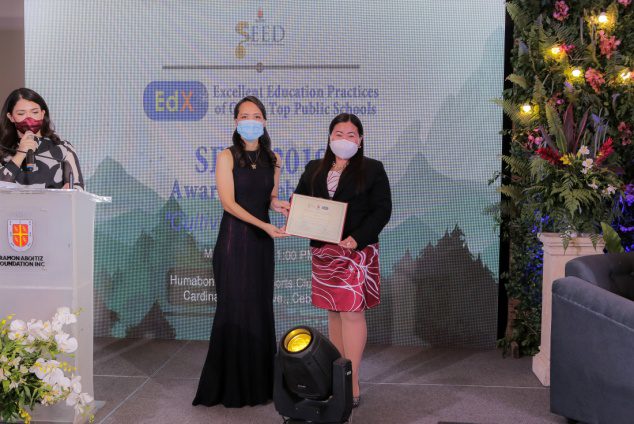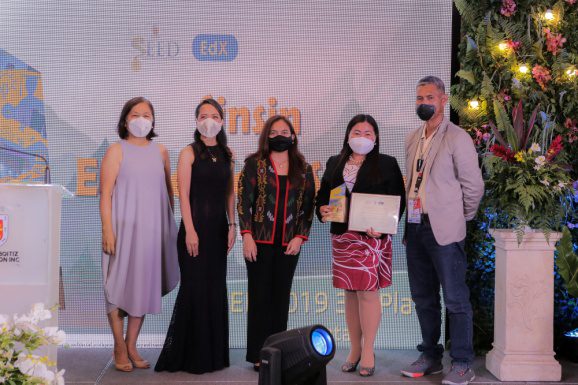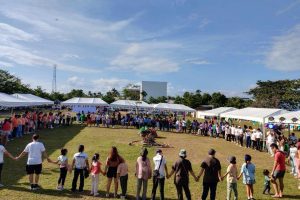Children who work at a young age to help their parents out is not an uncommon narrative here in the Philippines. In the rural areas of Sinsin, Cebu for example, children are expected to assist their parents in the farm every Friday. This means that they won’t be showing up at school for that day.
For these children, education and poverty seem to be two ends of a stick; two separate choices where one can’t happen at the same time with the other. They understand that education is important to get out of poverty, yet they are too entrenched in poverty to even have time for education. It’s a paradox that they can’t seem to get out of.
Not until Project Tambayayong. Here’s how the story of Sinsin Elementary School’s Project Tambayayong started.
The Unseen Story of Sinsin
Sinsin Elementary School is tucked right at the heart of Tabunok-Toledo Road in Cebu City. Behind the calm facade of the school, teachers had some pressing concerns that needed to be addressed. Aside from the facilities that have been worn down by time and weather, some of the children were not showing up as much as they should.
“When I first arrived here in Sinsin Elementary School, we had really experienced a big challenge. All facilities here are not functional. Even the lights are minimally functioning. Aside from that, the comfort rooms are also not functional. Our artesian well wasn’t functioning for a week.
It was a really really big challenge.
And besides that, another problem is the absenteeism of our pupils. Because every Friday, most of our pupils have to work together with their parents. Their main livelihood here is farming,” said Dr. Marivel B. Lacre.
Dr. Lacre knew that there were going to be some concerns that needed to be resolved in the school. But the rate of absenteeism and the poor rate of literacy were the ones that really surprised her. Fortunately, she wasn’t the type to give up so easily. Especially when the lives of the children she cares so much about are at stake.
So, she found some ways to bring back some life into the lackluster facilities of the school.
“I immediately coordinated with the barangay officials and with the school governing council, the PTA, alumni, and of course, the stakeholders to discuss all these problems in the school,” she recalled. She quickly became the incessant advocate of improving not only the school facilities, but of the lives of the children that go there to learn as well.
She emphasized the need for better facilities and improving the learning environment as a whole. Dr. Lacre, along with the teachers at Sinsin Elementary School, know that for learning to be effective, a conducive environment is necessary too.
But just because some strong-willed teachers advocated for change and improvement, doesn’t mean it was going to happen overnight. Some parents were skeptical. Understandably so. After all, who was going to help them out on the farm and make sure the family is fed? Some officials were concerned, too. How much is this project going to cost?
Ultimately, after weeks of campaigning on the children’s behalf, Dr. Lacre and the teachers of Sinsin finally had their first breakthrough.
“So, through our collective effort, our goals were finally realized. Now we have two fully-functioning artesian wells that are already connected with the comfort rooms and washing areas,” Dr. Lacre happily shared. But she and the other teachers of Sinsin weren’t stopping at improving the facilities alone. That’s when the Tambayayong Project came in.
The Tambayayong Project was born out of the need to continue what they started. Tambayayong seemed to be the perfect name for the project for it stands for collaboration and helping each other out. It wasn’t long before the teachers got the gears going for this project.
“We had the pre-implementation plan wherein the teachers were asked to give a list of parents who are capable of rendering free reading services to children who don’t know how to read. The barangay officials also requested a list of students who were usually absent during Fridays to help their parents.”
The teachers then set out to visit and talk to the parents. During their discussions, they asked the parents what they could do to help them. By doing so, they made sure that more children could attend school even on Fridays.
Marivic Abella, one of the parent-volunteers, said, “I volunteered for this so I can help the students. Among the impact of the project is on how the children who were not able to read can now read. We are also happy to give assistance to the children whenever needed.”
They gathered volunteers from parents and officials to alumni who were kind enough to spend their free time assisting the children. The teachers taught the volunteers on how to conduct remedials that they then coined, “Outdoor Tutorials.” The volunteers were not only taught how to conduct these tutorials, they were also provided with instructional materials that they can use for the remedial sessions.
These tutorials were instrumental in giving children who are still struggling to read, a chance to catch up with their peers. The decreasing rate of non-literates was testament to how effective this project was.
But there was still one hindrance that stood in the way of learning: the road itself.
The Road to Learning
The road that connects the school to the rest of the municipality is a small, two-foot pathway that’s riddled with rocks and grass. During the rainy season, the narrow pathway turns into a flooded pool of mud that prevents anyone from crossing it. Crossing this road every day was a struggle, more so when the children had to do it on foot. Dr. Lacre saw this road as another reason why children are discouraged to diligently attend school.
She brought this issue to the barangay officials who helped her negotiate with the landowners. The landowners were gracious enough to support the project, they even donated two meters of their own land. Together with the alumni, parents, and other volunteers, the road was renovated into a cemented paveway that’s better suited for vehicles. It is also safer to walk on now even when it rains.
The renovation of the road was more than just improving the landscape. It served as a symbol that marked Sinsin’s journey to becoming a hub of effective learning. Now, children have been going to school more consistently, resulting in zero dropouts in the past three years. Students are also better at reading and comprehension.
This just proved that through collaboration, or Tambayayong, anything is possible. What seemed to be impossible feats were realized thanks to the efforts and services of the entire community.
A Wish Granted
This inspiring story has earned them the Top 3 spot at the SEED 2019 Elementary Category. They were awarded Php500,000 worth of prize – something that they can use to take the Tambayayong Project even further. For us here at RAFI, we look forward to hearing more stories of excellence from Sinsin Elementary School.

It truly does take a village to raise a child. In Sinsin’s case, it took the entire municipality to take action and collaborate with each other to ensure that their children have a better shot at life. Brave individuals who have the willpower and the initiative to take action shaped the children’s lives forever. And for that, they deserve all the respect and appreciation in this world.
To all the teachers, parents, and volunteers, may you continue shedding light onto the children’s path towards better learning.












